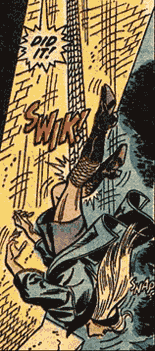Revisionist History 101
COMIC MYSTERIES EXPLAINS… GWEN STACY
Good evening ladies and gentlemen, and welcome to the first installment of R.V. 101. No we’re not talking about Saudi Arabian textbooks. What I’ll be going over is how those lovely movie folks like to take whole scenes out of their source material and then regurgitate some chuck-wagon, watered down version for mass consumption. So if you watch comic book movies but don’t read the comics, this is for you. I’ll be telling you the real history behind those computer generated movie scenes you love. In the spirit of our recently posted podcast, I’ll be starting with the first Spider-Man movie. So here we go…
This column will contain spoilers for Spider-Man 1-3.
 Most of the first installment in the Sony franchise was Spidey’s origin combined with the death of Gwen Stacy storyline from 1973. I can hear you already. No, Mary Jane was not young Parker’s first love. Yes, Gwen Stacy showed up in Spider-Man 3 for no reason whatsoever. See, now you know why you’re reading this. I’ll get back to that in a minute.
Most of the first installment in the Sony franchise was Spidey’s origin combined with the death of Gwen Stacy storyline from 1973. I can hear you already. No, Mary Jane was not young Parker’s first love. Yes, Gwen Stacy showed up in Spider-Man 3 for no reason whatsoever. See, now you know why you’re reading this. I’ll get back to that in a minute.
The first change concerned how he became our web-slinging hero in the first place. This is one of those rare changes that makes sense. In the original comic from 1962, a radioactive spider bit him. Now we know that such a thing will not give you powers, but will give you rapid weight and hair loss, followed by death. In the movie version 40 years later, we’ve updated to a genetically altered spider. Still a little hard to believe, but makes more sense. Good job on that screenplay, David Keopp!
In the very beginning of the movie Parker tells you it’s a story about a girl. That’s true except, in comic book history, that girl was a young blond undergrad named Gwen Stacy. Most of what you see in the movie with Peter Parker pining for the girl—but ultimately not getting involved because he’s Spider-Man—happened with Gwen. She eventually went on to date Harry… just like in the movie. I’ll spare you the sordid details but, just like in the movies, Peter and Gwen have an on-again-off-again relationship. This all ends with Ms. Stacy getting thrown off the George Washington Bridge by the Green Goblin. If that sounds familiar that’s because it is.
 In the movie they have the Goblin balancing a cable car full of kids in one hand and Mary Jane in the other. Thanks to some helpful New Yorkers (pissed that the Goblin is holding up traffic), the Goblin somehow gets distracted and Spider-Man saves everybody. In the comic he grabs Gwen with a web and hauls her back up—forgetting a fact that you don’t need to be a science major to know. In fact, thrill-seekers know it which is why they go bungee-jumping rather than rope-jumping. Do you know what happens without the bounce, kids? I’ll give you hint: snap, crackle, and pop. You read that right. Somehow a science-uber-geek who, as a teenager, built devices that could shoot steel-strength webs (yet another thing they changed in the movie, his body didn’t generate bungee-webs in the comic) somehow skipped the physics of sudden impact. Spider-Man accidentally killed his first love! Very controversial for the time as super heroes never really failed before. Peter Parker won the fight but lost the war and it changed him forever, just as the death of his Uncle Ben did. It was during his mourning for Gwen Stacy that he grew close to her friend, Mary Jane Watson.
In the movie they have the Goblin balancing a cable car full of kids in one hand and Mary Jane in the other. Thanks to some helpful New Yorkers (pissed that the Goblin is holding up traffic), the Goblin somehow gets distracted and Spider-Man saves everybody. In the comic he grabs Gwen with a web and hauls her back up—forgetting a fact that you don’t need to be a science major to know. In fact, thrill-seekers know it which is why they go bungee-jumping rather than rope-jumping. Do you know what happens without the bounce, kids? I’ll give you hint: snap, crackle, and pop. You read that right. Somehow a science-uber-geek who, as a teenager, built devices that could shoot steel-strength webs (yet another thing they changed in the movie, his body didn’t generate bungee-webs in the comic) somehow skipped the physics of sudden impact. Spider-Man accidentally killed his first love! Very controversial for the time as super heroes never really failed before. Peter Parker won the fight but lost the war and it changed him forever, just as the death of his Uncle Ben did. It was during his mourning for Gwen Stacy that he grew close to her friend, Mary Jane Watson.
So here we have a pivotal point in the development of the character, watered down into a feel-good CG moment. New Yorkers rally behind Spider-Man, yay! As a result, the girl (the wrong girl) lives, we get two more movies of relationship angst, and Mary Jane gets kidnapped by every villain in New York except Mike Bloomberg. We also get the death of the Green Goblin at the points of his own glider (which actually did happen in the comic). Except, of course, no villain stays dead in comics. It did take awhile but the Green Goblin returned.
So what we have in the movie is a reversal of deaths. The girl lives and the villain dies. Right now if you’re saying, “Who cares?”, I’ll tell you why you should. We ended up with, essentially, the same plot in all three movies. Mary Jane gets captured by a villain who knows Spider-Man has a connection to her. Spidey comes to the rescue and somehow pulls it off. Kiss the girl as the credits get ready to roll. You know in the end Spider-Man will always win. No one dies on his watch. No growth as a character for this Peter Parker. Ultimately no growth as a franchise which, as of this writing, is re-launching with a whole new cast.
Wouldn’t you have rather seen the real outcome? If you want to make a super hero seem human, let him fail. It would have given the character the edge of darkness that everyone seems to want these days, and the MJ relationship would have been saved to play out over the next two movies. It would have allowed for more of the focus to be on the hero and his villains, which could have stretched even further than two movies. Pushing everything back would have allowed a fourth movie to flow naturally with the same cast. Harry taking over as the Green Goblin could have then been the fourth movie, after he loses his girl to Peter.
Now, if that sounds better than what you saw on the screen, go look for The Amazing Spider-Man #121 from June of 1973 and start there. Umm, maybe look for an online download or a graphic novel; the good old comics get expensive that far back.
Happy hunting!


